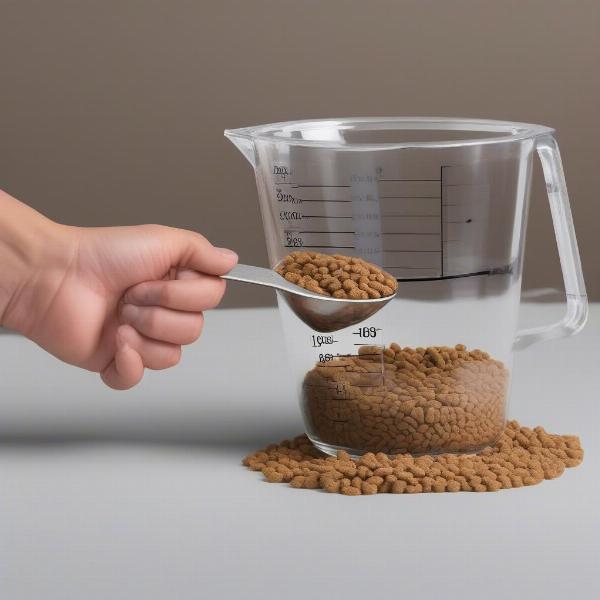Fat dog food isn’t a specific category of pet food, but the term often brings up questions about managing a dog’s weight through their diet. If you’re searching for “fat dog food,” you’re likely concerned about your dog’s weight and looking for ways to help them slim down. This article will guide you through understanding canine obesity, its health risks, and most importantly, how to choose the right food to support your dog’s weight loss journey. We’ll delve into the world of low-fat dog food, explore portion control, and discuss the importance of regular exercise. Let’s work together to ensure your furry friend lives a long, healthy, and active life.
Understanding Canine Obesity
Just like in humans, obesity in dogs can lead to a host of health problems. These include joint issues, heart disease, diabetes, and even a shortened lifespan. Recognizing whether your dog is overweight is the first step. While breed standards vary, a general rule of thumb is that you should be able to feel your dog’s ribs without pressing hard. If their ribs are difficult to feel under a layer of fat, they are likely overweight.
It’s essential to consult your veterinarian to rule out any underlying medical conditions that might be contributing to weight gain. They can also help you determine your dog’s ideal weight and recommend a suitable weight loss plan, including dietary changes and exercise routines.
Choosing the Right Food for a Fat Dog
While there isn’t a specific “fat dog food,” selecting a food that supports weight loss is crucial. Look for dog foods that are lower in fat and calories but higher in fiber and protein. Fiber helps your dog feel full and satisfied, preventing overeating, while protein helps maintain muscle mass during weight loss.
Avoid high-calorie treats and table scraps, which can quickly sabotage weight loss efforts. Instead, opt for healthy, low-calorie treats like carrots, green beans, or specially formulated dog treats designed for weight management. You can find information on low fat dog food for dogs with pancreatitis on our website.
The Role of Exercise in Weight Management
Diet alone isn’t enough to combat canine obesity. Regular exercise is just as important. The type and amount of exercise will depend on your dog’s breed, age, and overall health. Start with short walks and gradually increase the duration and intensity as your dog’s fitness improves. Playing fetch, swimming, and even engaging in puzzle toys can also contribute to burning calories and promoting a healthy weight.
Portion Control: A Key Factor
Even the healthiest dog food can contribute to weight gain if portions are too large. Follow the feeding guidelines on the dog food packaging, but remember that these are just estimates. You may need to adjust the amount based on your dog’s individual needs and activity level. royal canin intestinal low fat dog food can be a good option for some dogs.
 Measuring Dog Food
Measuring Dog Food
Weigh your dog regularly to monitor their progress and adjust their food intake accordingly. If you are struggling to manage your dog’s weight, consider consulting a veterinary nutritionist. They can provide personalized dietary recommendations tailored to your dog’s specific needs. You could also check out royal canin gastrointestinal low fat dog food for options.
Conclusion
Helping your dog achieve a healthy weight is a journey that requires patience, consistency, and a commitment to providing them with the right nutrition and exercise. By choosing a suitable low-fat dog food, controlling portions, and incorporating regular exercise into their routine, you can help your canine companion shed those extra pounds and enjoy a healthier, happier life. Remember to consult with your veterinarian for personalized guidance and support. Explore options like iams low fat dog food and low fat dog food pancreatitis uk for further information.
FAQ
- What are the signs of obesity in dogs? Difficulty feeling ribs, reduced activity levels, excessive panting, and difficulty moving.
- What health problems can obesity cause in dogs? Joint problems, heart disease, diabetes, respiratory issues, and a shortened lifespan.
- What should I look for in a low-fat dog food? High fiber, moderate protein, and lower fat content.
- How much exercise does an overweight dog need? Consult your vet for a personalized plan, but start with short walks and gradually increase duration and intensity.
- How can I control my dog’s food portions? Use a measuring cup and follow feeding guidelines, adjusting based on your dog’s individual needs and activity level.
- What are some healthy, low-calorie treats for dogs? Carrots, green beans, and specially formulated dog treats for weight management.
- When should I consult a veterinarian about my dog’s weight? If you suspect your dog is overweight or if they are struggling to lose weight despite dietary and exercise changes.
ILM Dog is your trusted resource for expert advice on dog care and nutrition. We offer valuable insights into various aspects of dog ownership, including breed selection, health care, training, nutrition, grooming, and product recommendations. From understanding the nuances of various breeds to addressing specific health concerns, ILM Dog is dedicated to providing dog owners with the knowledge and resources they need to ensure their furry companions thrive. Contact us today for expert advice and personalized guidance. Email: [email protected], Phone: +44 20-3965-8624.